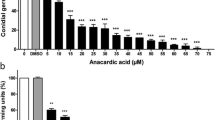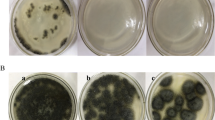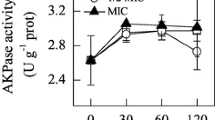Abstract
Garlic (Allium sativum) has long been known to have antifungal properties. The experiment demonstrated that garlic constituent diallyl trisulfide (DATS) suppressed the growth ofPenicillium expansum (minimum fungicidal concentration (MFC99) value: ≤ 90 μg/ml) and promoted apoptosisvia production of reactive oxygen species (ROS) and disintegration of cellular ultrastructure. The morphological changes of DATS-treated hyphal cells were analyzed by using TUNEL, Annexin-V FITC/propidium iodide and oxidant stress dichlorodihydrofluorescein. DATS treatment induced chromatin condensation, DNA fragmentation, phosphatidylserine (PS) externalization and intracellular ROS elevation. Transmission electron microscopy (TEM) investigation indicated DATS-treatment cellular ultrastructure (e.g., mitochondria) disappeared. In conclusion, DATS as one of the components of garlic was a good fungal pathogen inhibitor with many advantages, such as being common, cheap, non toxic and with high efficiency. It would be useful to further study DATS as a new antifungal agent applied inP. expansum control.
Similar content being viewed by others
References
Amagase H., Petesch B.L., Matsuura H., Kasuga S., Yoichi Itakura (2001). Intake of garlic and its bioactive components. J. Nutr., 131: 955–962.
Ankri S., Mirelman D. (1999). Antimicrobial properties of allicin from garlic. Microbes Infect., 2: 125–129.
Antosiewicz J., Herman-Antosiewicz A., Marynowski S.W., Singh S.V. (2006). c-Jun NH2-terminal kinase signaling axis regulates diallyl trisulfide-induced generation of reactive oxygen species and cell cycle arrest in human prostate cancer cells. Cancer Res., 6610): 5379–5386.
Cavallito C., Bailey J.H., Buck J.S. (1944). Allicin, the antibacterial principle ofAllium sativum I I. Its precursor and “essential oil” of garlic. J. Am. Chem. Soc, 67: 1032–1033,
Curtis H., Noll U., Störmann J., Slusarenko A.J. (2004). Broadspectrum activity of the volatile phytoanticipin allicin in extracts of garlicAllium sativum L. against plant pathogenic bacteria, fungi and Oomycetes. Physiol. Mol. Plant. Pathol., 65: 79–89.
Davis S.R., Perrie R. (2003). The in-vitro susceptibility ofScedosporium prolificans to ajoene, allitridium, and a raw extract of garlic (Allium sativum). J. Antimicrob. Chemother., 51: 593–597.
Davis S.R. (2005). An overview of the antifungal properties of allicin and its breakdown products—the possibility of a safe and effective antifungal prophylactic. Mycoses, 48 (2): 95–100.
de Capdeville G., Wilson C.L., Beer S.V., Aist J.R. (2002). Alternative disease control agents induce resistance to blue mold in harvested ‘Red Delicious’ apple fruit. Phytopathology, 92: 900–908.
Domsch K.H., Gams W., Anderson T.H. (1980). Compendium of Soil Fungi, vol. 1, Academic Press, London.
Harris J.C., Plummer S., Turner M.P., Lloyd D. (2000). The microaerophilic flagellateGiardia intestinalis: Allium sativum (garlic) is an effective antigiardial. Microbiology, 146: 3119–3127.
Hosono T., Fukao T., Ogihara J., Ito Y., Shiba H., Seki T., Ariga T. (2005). Diallyl trisulfide suppresses the proliferation and induces apoptosis of human colon cancer cells through oxidative modification of β-tubulin. J. Biol. Chem., 280 (50): 41487–41493.
Leiter E., Szappanos H., Oberparieiter C., Kaiserer L., Csernoch L., Pusztahelyi T., Emri T.,et al. (2005). Antifungal protein PAF severely affects the integrity of the plasma membrane ofAspergillus nidulans and induces an apoptosis-like phenotype. Antimicrob. Agents. Ch., 49: 2445–2453.
Lemar K.M., Turner M.P., Lloyd D. (2002). Garlic (Allium sativum) as an anti-Candida agent: a comparison of the efficacy of fresh garlic and freeze-dried extracts. J. Appl. Microbiol., 93: 398–405.
Lemar K.M., Passa O., Aon M.A., Cortassa S., Müller C.T., Plummer S., O’Rourke B., Lloyd D. (2005). Allyl alcohol and garlic (Allium sativum) extract produce oxidative stress inCandida albicans. Microbiology, 151: 3257–3265.
Lemar K.M., Aon M.A., Cortassa S., O’Rourke B., Müller C.T., Lloyd D. (2007). Diallyl disulphide depletes glutathione inCandida albicans: oxidative stress-mediated cell death studied by two-photon microscopy. Yeast, 24 (8): 695–706.
Li H., Li H.Q., Wang Y., Xu H.X., Fan W.T., Wang M.L., Sun P.H., Xie X.Y. (2004). An intervention study to prevent gastric cancer by microselenium and large dose of allitridum. Chin. Med. J., 117: 1155–1160.
Liu P., Deng B.-X., Long C.-A., Min X.F. (2009). Effect of farnesol on morphogenesis in the fungal pathogenPenicillium expansum. Ann. Microbiol., 59 (1): 33–38.
Obagwu. J., Korsten L. (2003). Control of citrus green and blue molds with garlic extracts. Eur. J. Plant. Pathol., 109: 221–225.
Pai S.T., Platt M.W. (1995). Antifungal effects ofAllium sativum (garlic) extract against theAspergillus species involved in otomycosis. Lett. Appl. Microbiol., 20: 14–18.
Poljak A., Dawes I.W., Ingelse B.A.,et al. (2003). Oxidative damage to proteins in yeast cells exposed to adaptive levels of H2O2. Redox. Rep., 8: 371–377.
Shen J.K., Davis L.E., Wallace J.M., Cai Y., Lawson L.D. (1996). Enhanced diallyl trisulfide has in vitro synergy with amphotericin B againstCryptococcus neoformans. Planta Medica, 62: 415–418.
Tsao S.M., Yin M.C. (2001). In-vitro antimicrobial activity of four diallyl sulphides occurring naturally in garlic and Chinese leek oils. J. Med. Microbiol., 50: 646–649.
Xiao D., Lew K.L., Kim Y., Zeng Y., Hahm E., Dhir R., Singh S.V. (2006). Diallyl trisulfide suppresses growth of PC-3 human prostate cancer xenograftin vivo in association with Bax and Bak induction. Clin. Cancer Res., 15: 6836–6843.
Xiao D., Zeng Y., Hahm E-R., Kim Y-A., Ramalingam S., Singh S.V. (2009). Diallyl trisulfide selectively causes bax- and bakmediated apoptosis in human lung cancer cells. Environ. Mol. Mutagen., 50: 201–212.
Zhou W.-W., Huang J.-X., Niu T.-G. (2008). Isolation of an antifungalPaenibacillus strain HT16 from locusts and purification of its medium-dependent antagonistic component. J. Appl. Microbiol., 10: 1363–1365.
Author information
Authors and Affiliations
Corresponding author
Rights and permissions
About this article
Cite this article
Liu, P., Guo, J., Liu, H. et al. Diallyl trisulfide (DATS) effectively induced apoptosis of postharvest diseasePenicillium expansum of citrus. Ann. Microbiol. 59, 675–679 (2009). https://doi.org/10.1007/BF03179207
Received:
Accepted:
Issue Date:
DOI: https://doi.org/10.1007/BF03179207




